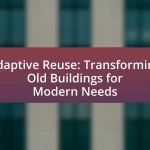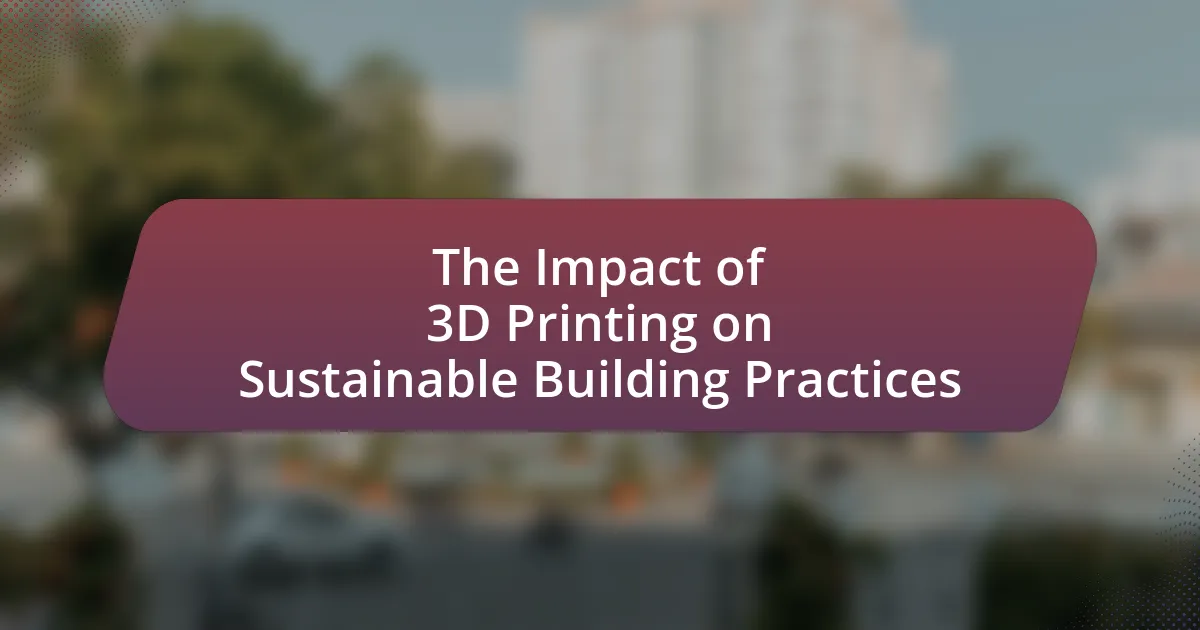Water conservation strategies in sustainable architecture are essential practices aimed at reducing water consumption and minimizing environmental impact. Key strategies include rainwater harvesting, greywater recycling, and drought-resistant landscaping, which collectively can lead to significant reductions in water usage—up to 50% in some cases. The article explores the principles behind these strategies, their influence on design choices, and the role of innovative technologies in enhancing water management. Additionally, it addresses the challenges architects face in implementing these strategies, the economic considerations involved, and the importance of stakeholder collaboration and community engagement in promoting effective water conservation initiatives.
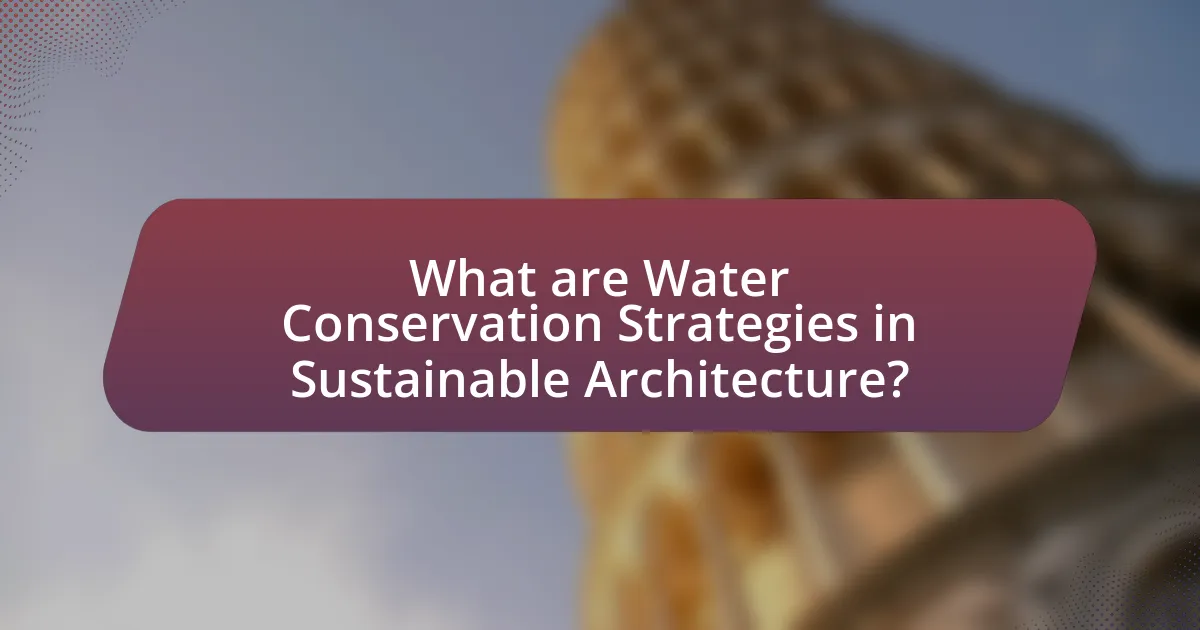
What are Water Conservation Strategies in Sustainable Architecture?
Water conservation strategies in sustainable architecture include rainwater harvesting, greywater recycling, and the use of drought-resistant landscaping. Rainwater harvesting systems collect and store rainwater for non-potable uses, significantly reducing reliance on municipal water supplies. Greywater recycling systems treat and reuse water from sinks, showers, and laundry for irrigation or toilet flushing, which can save up to 50% of indoor water use. Additionally, drought-resistant landscaping employs native plants that require minimal irrigation, further conserving water resources. These strategies are supported by studies indicating that implementing such measures can lead to a reduction in water consumption by up to 30% in residential buildings.
How do these strategies contribute to environmental sustainability?
Water conservation strategies in sustainable architecture significantly contribute to environmental sustainability by reducing water consumption and minimizing the impact on local water resources. These strategies, such as rainwater harvesting, greywater recycling, and the use of drought-resistant landscaping, help to lower the demand for freshwater, which is a limited resource. For instance, implementing rainwater harvesting systems can reduce potable water use by up to 50%, as reported by the U.S. Environmental Protection Agency. Additionally, greywater recycling can save approximately 30% of water used in residential settings, further alleviating pressure on municipal water supplies. By integrating these practices, sustainable architecture not only conserves water but also enhances ecosystem resilience and promotes responsible resource management.
What are the key principles behind water conservation in architecture?
The key principles behind water conservation in architecture include efficient water use, rainwater harvesting, greywater recycling, and sustainable landscaping. Efficient water use focuses on minimizing water consumption through fixtures and appliances that reduce flow rates, such as low-flow faucets and dual-flush toilets. Rainwater harvesting involves collecting and storing rainwater for non-potable uses, which can significantly reduce reliance on municipal water supplies. Greywater recycling captures water from sinks, showers, and washing machines for reuse in irrigation or toilet flushing, thereby conserving fresh water. Sustainable landscaping incorporates native and drought-resistant plants that require less irrigation, further promoting water conservation. These principles are supported by studies indicating that implementing such strategies can reduce water usage by up to 50% in residential buildings.
How do these principles influence design choices?
Water conservation principles significantly influence design choices in sustainable architecture by prioritizing efficient water use and minimizing waste. These principles guide architects to incorporate features such as rainwater harvesting systems, greywater recycling, and drought-resistant landscaping, which collectively reduce reliance on potable water sources. For instance, the implementation of rainwater harvesting can decrease water consumption by up to 50%, as evidenced by studies conducted in various sustainable building projects. Additionally, the integration of native plants in landscaping not only conserves water but also enhances biodiversity, demonstrating the multifaceted impact of these principles on design decisions.
What types of water conservation strategies are commonly used?
Commonly used water conservation strategies include rainwater harvesting, greywater recycling, xeriscaping, and the installation of low-flow fixtures. Rainwater harvesting captures and stores rainwater for non-potable uses, significantly reducing reliance on municipal water supplies. Greywater recycling involves reusing water from sinks, showers, and laundry for irrigation or toilet flushing, which can save up to 50% of household water usage. Xeriscaping is a landscaping approach that utilizes drought-resistant plants to minimize irrigation needs, effectively conserving water in arid regions. Low-flow fixtures, such as faucets, showerheads, and toilets, reduce water consumption without sacrificing performance, contributing to overall water savings in buildings. These strategies are essential in sustainable architecture to promote efficient water use and reduce environmental impact.
What is rainwater harvesting and how is it implemented?
Rainwater harvesting is the process of collecting and storing rainwater for reuse, primarily for irrigation, domestic use, or groundwater recharge. Implementation involves several key steps: first, a catchment area, typically a roof, is designed to collect rainwater; second, a system of gutters and downspouts directs the water into storage tanks; third, filtration systems are installed to ensure water quality; and finally, the stored water is distributed for various uses. According to the United Nations, rainwater harvesting can significantly reduce reliance on conventional water sources, promoting sustainability in architecture and urban planning.
How does greywater recycling work in sustainable buildings?
Greywater recycling in sustainable buildings involves the collection, treatment, and reuse of wastewater generated from non-toilet sources such as sinks, showers, and washing machines. This process typically includes a filtration and disinfection system that ensures the greywater is safe for reuse in applications like irrigation, toilet flushing, and cooling systems. According to the U.S. Environmental Protection Agency, implementing greywater recycling can reduce water consumption by up to 50%, significantly contributing to water conservation efforts in sustainable architecture.
What role does landscaping play in water conservation strategies?
Landscaping plays a crucial role in water conservation strategies by utilizing design techniques that enhance water retention and reduce runoff. Effective landscaping practices, such as xeriscaping, incorporate drought-resistant plants and efficient irrigation systems, which can reduce water usage by up to 50% compared to traditional landscaping methods. Additionally, the implementation of permeable surfaces and rain gardens allows for better absorption of rainwater, further minimizing the need for supplemental irrigation. These strategies not only conserve water but also promote sustainable land management and ecosystem health.
How can xeriscaping reduce water usage?
Xeriscaping can reduce water usage by utilizing drought-resistant plants and efficient landscaping techniques that minimize the need for irrigation. This approach focuses on selecting native or adapted plants that require less water, thereby significantly lowering overall water consumption. Studies indicate that xeriscaping can reduce landscape water use by up to 50% compared to traditional landscaping methods, as it emphasizes soil improvement, mulching, and efficient irrigation systems.
What are the benefits of using native plants in landscaping?
Using native plants in landscaping offers numerous benefits, particularly in promoting water conservation. Native plants are adapted to local climate and soil conditions, which means they require less water and maintenance compared to non-native species. Research indicates that native plants can reduce landscape water use by up to 50% because they are more resilient to local drought conditions. Additionally, native plants support local ecosystems by providing habitat for wildlife and pollinators, which enhances biodiversity. This ecological balance further contributes to sustainable water management by maintaining healthy soil and reducing erosion.
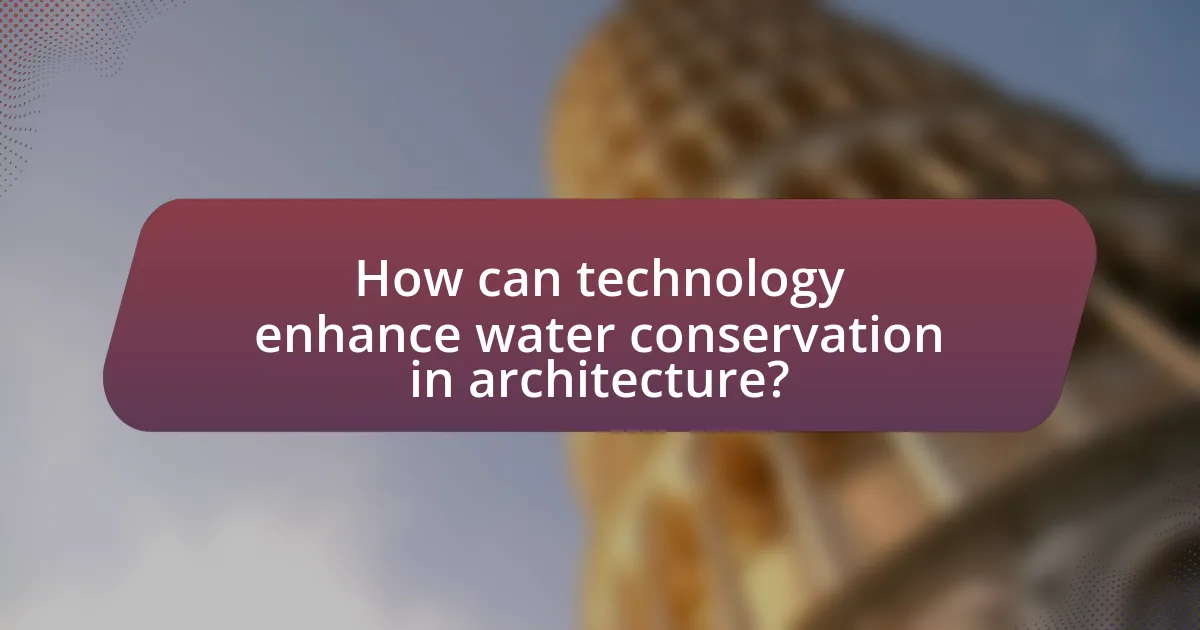
How can technology enhance water conservation in architecture?
Technology can enhance water conservation in architecture through the implementation of smart water management systems. These systems utilize sensors and data analytics to monitor water usage in real-time, allowing for immediate adjustments to reduce waste. For instance, rainwater harvesting systems can be integrated with building management software to optimize the collection and use of rainwater for irrigation and non-potable applications, significantly decreasing reliance on municipal water supplies. According to a study by the American Society of Civil Engineers, buildings equipped with such technologies can reduce water consumption by up to 50%. Additionally, advanced irrigation technologies, such as drip irrigation and soil moisture sensors, ensure that water is delivered efficiently to plants, minimizing evaporation and runoff.
What innovative technologies are being used for water management?
Innovative technologies used for water management include smart irrigation systems, rainwater harvesting, and advanced water treatment technologies. Smart irrigation systems utilize sensors and weather data to optimize water usage, reducing waste by up to 50% compared to traditional methods. Rainwater harvesting systems capture and store rainwater for reuse, which can significantly decrease reliance on municipal water supplies. Advanced water treatment technologies, such as membrane filtration and reverse osmosis, enable the recycling of wastewater, making it safe for non-potable uses. These technologies collectively enhance water efficiency and sustainability in architecture.
How do smart irrigation systems optimize water use?
Smart irrigation systems optimize water use by utilizing sensors and data analytics to deliver precise amounts of water based on real-time environmental conditions. These systems monitor soil moisture levels, weather forecasts, and plant water requirements, allowing for targeted irrigation that reduces waste. For instance, studies show that smart irrigation can reduce water usage by up to 30% compared to traditional methods, as they only irrigate when necessary, thus conserving water resources effectively.
What role do water-efficient fixtures play in conservation efforts?
Water-efficient fixtures significantly reduce water consumption, playing a crucial role in conservation efforts. These fixtures, such as low-flow toilets, faucets, and showerheads, can decrease water usage by 20-60% compared to standard models. For instance, the U.S. Environmental Protection Agency estimates that if every home in the U.S. replaced just one faucet with a water-efficient model, it could save over 1 trillion gallons of water annually. This reduction not only conserves a vital resource but also lowers water bills and decreases the energy required for water heating, contributing to overall sustainability in architecture.
How can building materials impact water conservation?
Building materials can significantly impact water conservation by influencing water usage during construction and throughout a building’s lifecycle. For instance, materials such as permeable concrete and green roofs can enhance stormwater management, allowing rainwater to infiltrate the ground rather than run off, which reduces the demand for irrigation and municipal water systems. Additionally, using materials with high thermal mass, like adobe or rammed earth, can minimize the need for water-intensive cooling systems, thereby conserving water indirectly. Research indicates that buildings designed with water-efficient materials can reduce overall water consumption by up to 30%, demonstrating the critical role of material selection in sustainable architecture.
What materials are considered water-efficient in construction?
Water-efficient materials in construction include low-flow fixtures, permeable paving, and drought-resistant landscaping materials. Low-flow fixtures, such as faucets and toilets, reduce water usage significantly, often by 30% or more compared to standard models. Permeable paving allows rainwater to infiltrate the ground, reducing runoff and promoting groundwater recharge. Drought-resistant landscaping materials, like native plants and xeriscaping techniques, minimize irrigation needs by utilizing plants that thrive in local climates. These materials collectively contribute to sustainable architecture by conserving water resources and promoting environmental stewardship.
How does the choice of materials affect overall water usage?
The choice of materials significantly affects overall water usage in sustainable architecture by determining the water footprint associated with their production, maintenance, and disposal. For instance, materials like concrete and steel require substantial water for their manufacturing processes, with concrete needing approximately 1,600 liters of water per cubic meter produced. In contrast, sustainable materials such as bamboo or recycled steel often have lower water requirements, promoting water conservation. Additionally, the selection of materials influences the efficiency of water use in buildings; for example, materials that enhance insulation can reduce the need for water-intensive cooling systems. Thus, selecting materials with lower water footprints and better thermal performance can lead to substantial reductions in overall water usage in architectural projects.
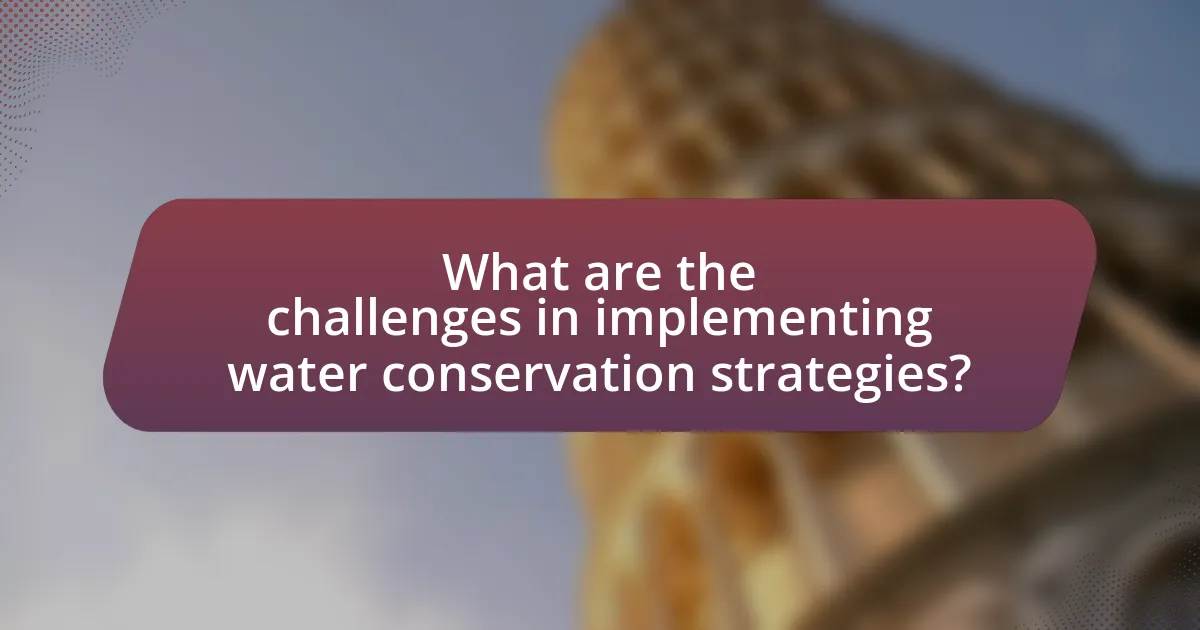
What are the challenges in implementing water conservation strategies?
The challenges in implementing water conservation strategies include financial constraints, lack of public awareness, and regulatory barriers. Financial constraints often hinder the adoption of advanced technologies and infrastructure necessary for effective water conservation. For instance, a study by the American Society of Civil Engineers indicates that inadequate funding for water infrastructure leads to inefficiencies and waste. Lack of public awareness results in low participation in conservation programs, as many individuals do not understand the importance of water conservation or how to implement it in their daily lives. Additionally, regulatory barriers can complicate the implementation of new conservation measures, as existing laws may not support innovative practices or technologies. These challenges collectively impede the effectiveness of water conservation strategies in sustainable architecture.
What barriers do architects face in adopting these strategies?
Architects face several barriers in adopting water conservation strategies in sustainable architecture, primarily including high initial costs, lack of client awareness, and regulatory challenges. High initial costs deter architects from implementing advanced water-saving technologies, as these can require significant upfront investment despite long-term savings. Additionally, many clients may not prioritize water conservation, leading to insufficient demand for such strategies, which further complicates architects’ efforts to incorporate them into designs. Regulatory challenges, such as outdated building codes and zoning laws, can also hinder the integration of innovative water conservation methods, as architects must navigate complex legal frameworks that may not support sustainable practices.
How do regulatory frameworks influence water conservation practices?
Regulatory frameworks significantly influence water conservation practices by establishing legal standards and guidelines that govern water usage and management. These frameworks often mandate specific conservation measures, such as limits on water extraction, requirements for water-efficient technologies, and incentives for sustainable practices. For instance, the Clean Water Act in the United States sets regulations that protect water quality and promote conservation efforts, leading to improved water management practices among industries and municipalities. Additionally, local building codes may require the installation of water-saving fixtures in new constructions, directly impacting water consumption patterns. Such regulations create a structured environment that encourages compliance and fosters innovation in water conservation technologies.
What are the economic considerations for implementing these strategies?
The economic considerations for implementing water conservation strategies in sustainable architecture include initial investment costs, long-term savings on water bills, and potential increases in property value. Initial investments may involve higher upfront costs for technologies such as rainwater harvesting systems or efficient plumbing fixtures, which can deter some stakeholders. However, these investments often lead to significant long-term savings; for instance, buildings that utilize water-efficient systems can reduce water consumption by up to 50%, resulting in lower utility expenses over time. Additionally, properties that incorporate sustainable water practices may experience increased market value, as buyers increasingly prioritize eco-friendly features. According to a study by the U.S. Green Building Council, green buildings can command a price premium of 7% to 10% compared to traditional buildings, highlighting the economic benefits of implementing water conservation strategies.
How can stakeholders collaborate to improve water conservation efforts?
Stakeholders can collaborate to improve water conservation efforts by forming partnerships that leverage their unique resources and expertise. For instance, local governments can work with non-profit organizations to implement community education programs that raise awareness about water-saving practices, while businesses can invest in innovative technologies that enhance water efficiency in buildings. Research indicates that collaborative initiatives, such as the WaterSense program by the U.S. Environmental Protection Agency, have successfully promoted water-efficient products and practices, leading to significant reductions in water use across various sectors. By sharing data, resources, and best practices, stakeholders can create a more comprehensive approach to water conservation that benefits both the environment and the community.
What roles do architects, builders, and clients play in this collaboration?
Architects, builders, and clients each play distinct yet interconnected roles in the collaboration for water conservation strategies in sustainable architecture. Architects are responsible for designing structures that incorporate efficient water management systems, such as rainwater harvesting and greywater recycling, ensuring that the design aligns with sustainability principles. Builders implement these designs, selecting materials and construction methods that enhance water efficiency and comply with environmental regulations. Clients, on the other hand, provide the vision and budget for the project, influencing decisions on water conservation features based on their priorities and values. This collaborative effort is essential for creating buildings that effectively conserve water while meeting functional and aesthetic needs.
How can community engagement enhance water conservation initiatives?
Community engagement enhances water conservation initiatives by fostering collective responsibility and awareness among residents. When communities actively participate in water conservation efforts, they are more likely to adopt sustainable practices, such as rainwater harvesting and efficient irrigation techniques. Research indicates that community-led programs can lead to a 20-30% reduction in water usage, as seen in initiatives like the “WaterWise” program in Australia, which successfully engaged local residents in conservation efforts. This collaborative approach not only increases the effectiveness of water-saving measures but also builds a sense of ownership and accountability, ultimately leading to long-term behavioral changes in water use.
What are best practices for effective water conservation in sustainable architecture?
Best practices for effective water conservation in sustainable architecture include the implementation of rainwater harvesting systems, the use of low-flow fixtures, and the incorporation of drought-resistant landscaping. Rainwater harvesting systems can capture and store rainwater for irrigation and non-potable uses, significantly reducing reliance on municipal water supplies. Low-flow fixtures, such as faucets, showerheads, and toilets, can reduce water consumption by up to 50%, as reported by the U.S. Environmental Protection Agency. Drought-resistant landscaping, or xeriscaping, minimizes water usage by selecting native plants that require less irrigation, promoting sustainability and reducing water waste. These strategies collectively enhance water efficiency and contribute to the overall sustainability of architectural projects.
How can architects incorporate water conservation strategies from the design phase?
Architects can incorporate water conservation strategies from the design phase by integrating efficient plumbing systems, selecting drought-resistant landscaping, and implementing rainwater harvesting systems. Efficient plumbing systems reduce water usage through low-flow fixtures and smart irrigation controls, which can decrease water consumption by up to 30%. Drought-resistant landscaping minimizes the need for irrigation, promoting native plants that thrive in local climates. Rainwater harvesting systems capture and store rainwater for non-potable uses, potentially reducing reliance on municipal water supplies by 50% in some regions. These strategies collectively enhance sustainability and resource efficiency in architectural design.
What ongoing maintenance practices are essential for sustaining water conservation efforts?
Ongoing maintenance practices essential for sustaining water conservation efforts include regular inspection and repair of plumbing systems, monitoring irrigation systems for efficiency, and maintaining water-efficient appliances. Regular inspections help identify leaks and inefficiencies, which can waste significant amounts of water; for instance, the U.S. Environmental Protection Agency estimates that leaks in homes can account for over 1 trillion gallons of water wasted annually. Monitoring irrigation systems ensures that water is applied only when necessary, reducing overwatering and runoff. Additionally, maintaining water-efficient appliances, such as low-flow fixtures and dual-flush toilets, ensures they operate effectively, contributing to overall water savings. These practices collectively support sustained water conservation in sustainable architecture.

